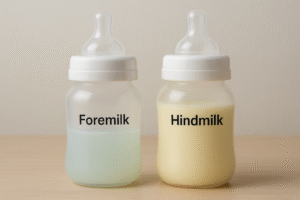Understanding Why Breast Milk Appears Blue
If you’ve noticed your pumped milk looking slightly bluish or translucent, don’t panic — it’s completely normal. Breast milk color changes frequently based on your body’s hydration, your baby’s feeding stage, and your overall diet. A bluish tint doesn’t mean something is wrong; it often signals a higher water content, especially during the foremilk stage.
According to the U.S. Centers for Disease Control and Prevention (CDC), normal breast milk can appear white, blue, or even yellow depending on its composition and timing. This guide breaks down why breast milk may look blue and what it means for your baby’s nutrition.
👉 For a broader understanding of milk color changes, read our detailed guide on What Color Should Breast Milk Be?
The Foremilk and Hindmilk Connection
Breast milk naturally shifts throughout a feeding session. The first milk your baby gets — called foremilk — is thinner and more watery to hydrate your baby. This milk can appear bluish or clear in color.
As feeding continues, the milk becomes richer and fattier — known as hindmilk. Hindmilk tends to look creamy white or yellow.
So if you’ve pumped early in a session or collected milk after a short nursing period, a bluish tint simply means you’ve captured more foremilk.
Nutritional Value of Blue-Tinted Milk
Despite its appearance, blue breast milk is perfectly nutritious. The color difference doesn’t affect the balance of proteins, antibodies, or essential nutrients. Your baby is still getting all the immune-boosting properties and hydration they need.
It’s important not to compare your milk color to other moms’ — every mother’s milk composition is unique.
Diet and Hydration Effects
Your diet and hydration play subtle roles in milk color. For example:
- Increased hydration can make milk appear more translucent or blue.
- Iron supplements, leafy greens, or high-fat meals may cause slight shifts in hue.
- Pumping conditions (like light reflection through milk bags) can exaggerate the blue tone.
None of these changes indicate poor quality — they’re part of natural variation.
When to Be Concerned
In rare cases, unusual milk color may signal contamination or blood presence.
Call your healthcare provider if you notice:
- A greenish-blue tint that persists with a foul odor
- Pink or brown streaks (possible blood traces)
- Sour smell or curdled texture even when freshly pumped
If none of these apply and your milk smells sweet or neutral, your blue milk is completely safe.
💡 Lipase Activity Note:
If your milk also smells soapy or metallic, this may be due to lipase enzyme activity, which breaks down fat — it’s safe but can alter the taste slightly. Learn more in our guide How to Tell If Frozen Breast Milk Is Bad.
How to Ensure Balanced Milk
If your milk consistently appears blue, it might be due to short pumping sessions that collect mostly foremilk. To balance foremilk and hindmilk:
- Pump longer from each breast — ideally for 15–20 minutes per session to allow the richer hindmilk to flow.

- Massage your breasts gently before and during pumping.
- Alternate starting breasts at each feeding.
🍼 Added Tip:
If your milk often looks blue, continue pumping until the breast feels completely empty during your next feed or session. This ensures your baby gets both hydrating foremilk and rich hindmilk.
For working moms or those building a freezer stash, read How to Store Breast Milk on the Go for proper storage and transport techniques.
How to Store Blue Breast Milk Safely

Proper storage prevents oxidation and bacterial growth — two factors that can alter milk’s natural color over time.
- Refrigerate immediately after pumping at 39°F (4°C).
- Use within 4 days, or freeze at 0°F (–18°C) for up to 6 months.
- Label every storage bag with the date and time.
- Avoid temperature fluctuation — frequent thawing and refreezing can affect milk color and fat distribution.
For detailed temperature guidelines, read Breast Milk Storage: Complete U.S. Mom’s Guide (2025 Edition).
💡 FAQ: Blue Breast Milk Explained
Q1: Is blue breast milk normal?
Yes. It’s usually foremilk — thinner, more watery, and full of hydration for your baby.
Q2: Does blue milk mean it has less fat?
Temporarily, yes. Foremilk contains slightly less fat than hindmilk, but both are essential for baby’s nutrition.
Q3: Can dehydration affect milk color?
Yes. When you’re well-hydrated, milk may appear clearer or bluer due to higher water content.
Q4: Can I mix blue milk with creamy milk?
Yes! Just ensure both portions are the same temperature first. Learn more in our related post Can I Mix Warm and Cold Breast Milk?
Conclusion: Blue Milk Means Your Body Is Doing Its Job
Blue-tinted breast milk is a sign of normal biological variation — not a red flag. It simply shows your body’s ability to adjust milk composition based on your baby’s needs. From hydration to fat balance, every color shift tells a story of adaptation and nourishment.
If you ever feel uncertain, remember: color changes are normal, but sour smells are not.
When in doubt, refrigerate promptly and check our guide on How to Store Breast Milk on the Go for real-life storage tips.
🧩 Enhancement Notes (Content Refinement for Maximum Value)
✅ Pumping Technique Addition:
If your milk often appears bluish, continue pumping until each breast feels completely empty. This helps ensure hindmilk collection, balancing the fat-rich and watery portions.
✅ Time Reference Suggestion:
In the How to Ensure Balanced Milk section, mention:
“Pump for a full 15–20 minutes per session to allow sufficient time for the richer hindmilk to be expressed.”
This adds clarity and connects naturally with your earlier post on How Long to Pump.
✅ Why It Matters:
Short sessions often collect more foremilk, which explains the bluish hue. Adding this note ensures readers understand that milk color isn’t about quality — it’s about timing.
External References:












This Post Has One Comment
Thank you